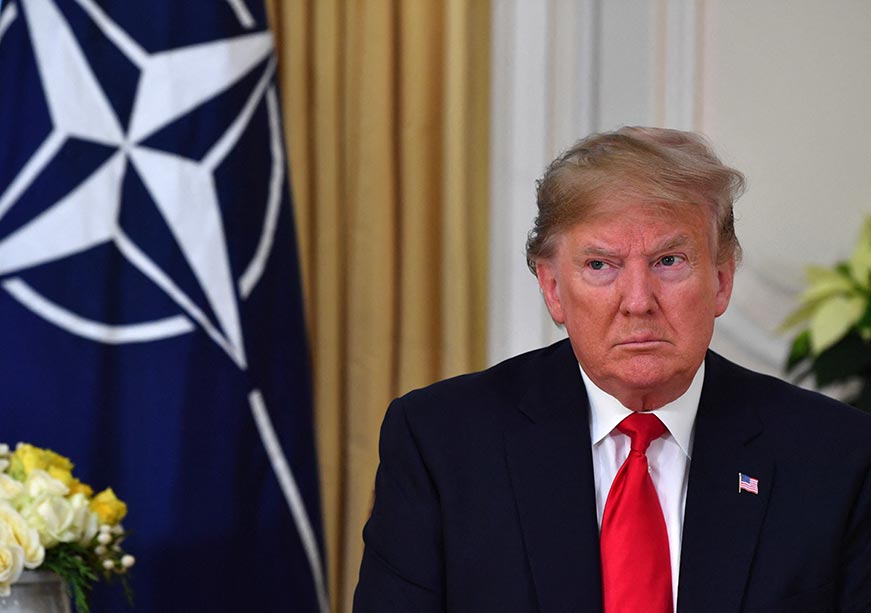-
CENTRES
Progammes & Centres
Location
Trump’s previous approach to NATO has led to increased nuclear and security threats in Europe, and the US must reaffirm its commitment to NATO to prevent more instability

Image Source: Getty
In February 2024, then-Republican presidential candidate Donald Trump voiced dissatisfaction with the 2 percent of the gross domestic product (GD) defence spending target set by the European members of the North Atlantic Treaty Organization (NATO), urging them to increase it to 3 percent. He also threatened not to extend protection to those members unwilling to fulfil this requirement.
Trump’s first term was dominated by a United States (US)-centric approach and the same is expected to define his upcoming second term. During the Russia-Ukraine war, Trump frequently criticised the Biden administration’s level of involvement. In his speech in February 2024, Trump used the issue of NATO defence spending to bolster his argument to withdraw the US from being a primary supporter of Ukraine.
Trump’s first term was dominated by a United States (US)-centric approach and the same is expected to define his upcoming second term.
As of November 2024, Trump’s speech is no longer just a possibility but a recollection of his previous term’s actions. In 2019, the Trump administration withdrew from the INF Treaty (1987 Intermediate-Range Nuclear Forces Treaty), leaving only the New START treaty to address US-Russian agreements on deploying nuclear weapons. The New START treaty has also been criticised by many experts and by Trump himself, who wants to negotiate a new treaty altogether, maintaining that the New START treaty alone is insufficient to limit the use of nuclear weapons. Earlier this year, Russian President Vladimir Putin had claimed that Western support in Ukraine, in the form of long-range missiles, may see a Russian nuclear response. While many US policy experts have criticised this as a near-impossible outcome, Putin’s rhetoric may have shaped the US sentiment of wanting to withdraw.
The New START treaty has also been criticised by many experts and by Trump himself, who wants to negotiate a new treaty altogether, maintaining that the New START treaty alone is insufficient to limit the use of nuclear weapons.
US’s potential withdrawal from Ukraine would directly impact European powers, forcing countries like Germany to take a more prominent role and contribute more to their defence budget, something they have hesitated to do thus far, which would strain alliances within Europe and cohesion within NATO. Russia’s nuclear posturing will exacerbate tensions within NATO and between the European Union (EU) and the US. The previous Trump administration threatened to withdraw from NATO. While this did not materialise, the fear around the withdrawal indicated to competing global powers, like China and Russia, that NATO and the US do not function independently. The EU and NATO could come under growing pressure to strengthen their militaries, which could then heighten geopolitical differences, both within Europe and with the US. At its 75th anniversary Summit in July 2024, NATO tried to address its stance against Russia. However, its continued reliance on the US and hesitation to make Ukraine a full member has dampened these efforts.
At the 2024 Summit in Washington D.C., NATO reaffirmed its status on nuclear weapons and development, identifying nuclear weapons as an instrument of international security and deterrence, especially in reaction to the Russia-Ukraine war. As mentioned earlier, Russia has also reaffirmed its willingness to use nuclear weapons. Both Russia and the NATO countries gesturing to potential nuclear weapons use only indicates that the Nuclear Non-Proliferation Treaty (NPT) and its attempt to contain nuclear proliferation is far from being successful. Furthermore, Finland and Sweden joining NATO may also impact the NPT. So far, these countries have opted out of alliances with nuclear weapons. Although neither of them possesses nuclear weapons, they are now a part of NATO and are under the protection of its nuclear umbrella. This inclusion will require these new members to strictly adhere to the required 2 percent (of GDP) defence spending.
Both Russia and the NATO countries gesturing to potential nuclear weapons use only indicates that the Nuclear Non-Proliferation Treaty (NPT) and its attempt to contain nuclear proliferation is far from being successful.
Trump's long-standing criticism of NATO and Europe’s military expenditure has had a lasting impact on transatlantic relations. States such as France and Germany may further develop autonomously operated military systems, potentially leading to different approaches in how NATO responds to security threats. Furthermore, Trump's support for a more hawkish posture towards the European military may induce reappraisals of Europe's reliance on the United States for military deterrence.
Rather than withdrawing or reducing its involvement in NATO, The US can approach the region more practically to reinvigorate the alliance’s defence posture, ensuring that its nuclear deterrence capabilities remain robust and relevant to the modern security environment. The next presidential term presents an opportunity to reactivate relationships with NATO partners and reiterate collective defence and nuclear security guarantees.
Further, the US also can and should be at the forefront of supporting arms control, particularly due to the nuclear risk to Europe and West Asia. While Trump’s “maximum pressure” campaign against Iran has led to significant tensions, especially with Türkiye, a more balanced approach that combines deterrence with diplomacy would be more successful. The US can thus tackle the nuclear threat posed by Tehran, by maintaining its relationship with Britain, France and Germany, who are already addressing the problem, thereby helping restore stability in the region. The United States must continue its adherence to arms control treaties, including the aforementioned New START Treaty between the US and Russia, and continue to spearhead efforts to stop the proliferation of nuclear weapons through international mechanisms.
The US must continue to engage with NATO and its allies, reaffirming the importance of collective defence and nuclear deterrence, while simultaneously advancing efforts to prevent further nuclear proliferation and reduce the risk of catastrophic conflict.
In a changed geopolitical landscape in which new nuclear powers are emerging and state and non-state actors are challenging alliances, NATO must not only relaunch its nuclear posture, but also mobilise its members based on shared security, diplomacy, and arms control. The US must continue to engage with NATO and its allies, reaffirming the importance of collective defence and nuclear deterrence, while simultaneously advancing efforts to prevent further nuclear proliferation and reduce the risk of catastrophic conflict. Trump’s policies in his first term perceptibly altered NATO’s strategy for defence and nuclear security, by essentially enfeebling the alliance. The foundations of a stable, secure international order call for NATO to remain firm, steadfast, and able to respond to traditional and nuclear threats. Rather than withdrawing, the United States should seek to reaffirm its commitment to NATO, enhance nuclear security efforts, and work collaboratively with its allies to address emerging threats.
Shravishtha Ajaykumar is an Associate Fellow with the Centre for Security, Strategy and Technology at the Observer Research Foundation.
The views expressed above belong to the author(s). ORF research and analyses now available on Telegram! Click here to access our curated content — blogs, longforms and interviews.

Shravishtha Ajaykumar is Associate Fellow at the Centre for Security, Strategy and Technology. Her fields of research include geospatial technology, data privacy, cybersecurity, and strategic ...
Read More +